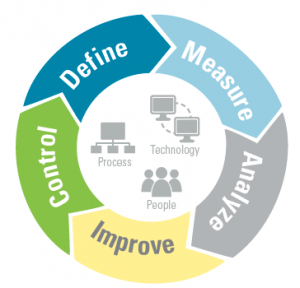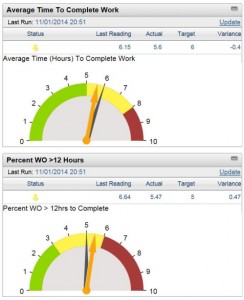Glenn Fawcett, director of business transformation services
Asset owners are continually striving to do more with less and often see technology as the catalyst for change; however, demonstrating a return on IT investments is proving elusive to many agencies. Adopting a “business transformation” approach can help focus IT-enabled change on the “Why” and improve your chance of demonstrating a successful return on your investment in asset management systems.
Successful business transformation engagements use a structured approach based on well-established change management frameworks. One such framework is Six Sigma deployed initially by Motorola in the late 80s and made core to GE’s change effectiveness program in the mid-90s. While heavily geared toward the manufacturing industry, it is a useful 5-step framework to explain why IT-enabled change projects are often challenged.
The hypothesis is that many IT engagements start without sufficient time defining the business needs (step 1) and the measures of success in terms of quantifiable business benefits (step 2). Without adequate effort in defining the “Why,” projects can become focused on bloated technical requirements offered by enterprise software systems and not on a clear and concise set of business outcomes or success measures. In its CHAOS Manifesto, The Standish Group has been monitoring IT deployments since 1996 and reports that as much as 50% of functionality deployed is rarely or never used. To sell software in a crowded market place (and many products for that matter), vendors must load in functionality for the inevitable capability shootouts that occur during the selection process.
This disproportionate focus on technology and capability comes at the cost of the other two pillars of successful change; People and Process. GE’s Change Acceleration Process quite simply noted that the effectiveness (E) of a change initiative was the product of the quality (Q) of the technical solution (Q) and the acceptance (A) of that solution by the business; Q x A = E (Change Effectiveness Equation, GE’s “Work-Out” campaign, early 90s).
The figure below presents a six sigma aligned framework which if executed from start to finish can help improve your chances of successfully demonstrating a return on your investment in IT-enabled change in your organization.
Early in the process, it is important to facilitate a deep dive discovery to understand the current business process drivers and pain points. These workshops bring together a cross-section of the organization – from the executive suite to the operations staff – to discuss current issues, problems and concerns, and document resulting “unmet needs” and “problem statements.”
Let’s look at an example of the way a utility might “Respond to a Customer Reported Incident,” such as a pipe burst or water contamination event. The discover process might identify (amongst other things) that:
- There are too many points of contact for logging events
- Calls are often lost resulting in 5-10 callbacks a week
- Crews don’t always receive the right information resulting in rework and lost time
- Customers don’t know who to call resulting in complaints tying up the time of our engineers and managers
A resulting problem statement might then be defined as:
“Customers reported events are managed by too many people in a non-systematic manner, which has resulted in a 30% decline in our customer satisfaction rating and $850,000 per year in costs associated with our first response crews. This improvement initiative will centralize call management and dispatching to improve the customer experience, reduce response times and deploy our workforce more efficiently”.
Measures of success would likely include:
- Customer satisfaction rating (through a closeout survey or regular customer engagement survey)
- Average time to respond to an incident
- Number of incidents resolved per crew
- Number of incidents that take > 8 hours to resolve (reducing variability is a key step in change)
- OPEX crew costs (a more efficient response could target some workforce savings)
As becomes very clear, to solve this problem the business could look to some level of technology enablement in the form of mobile dispatching capability, but that largely a successful outcome will only be achieved if processes are improved, communication with customers is improved and staff are better trained to respond.
When successful, a business transformation approach to technology enablement projects allows organizations to:
- Focus on the 25% of functionality that returns 80% of value
- Communicate process improvements rather than IT functionality
- Become 70 – 80% about the people, process and data and less about the widgets
- Target measureable improvements and tangible returns



